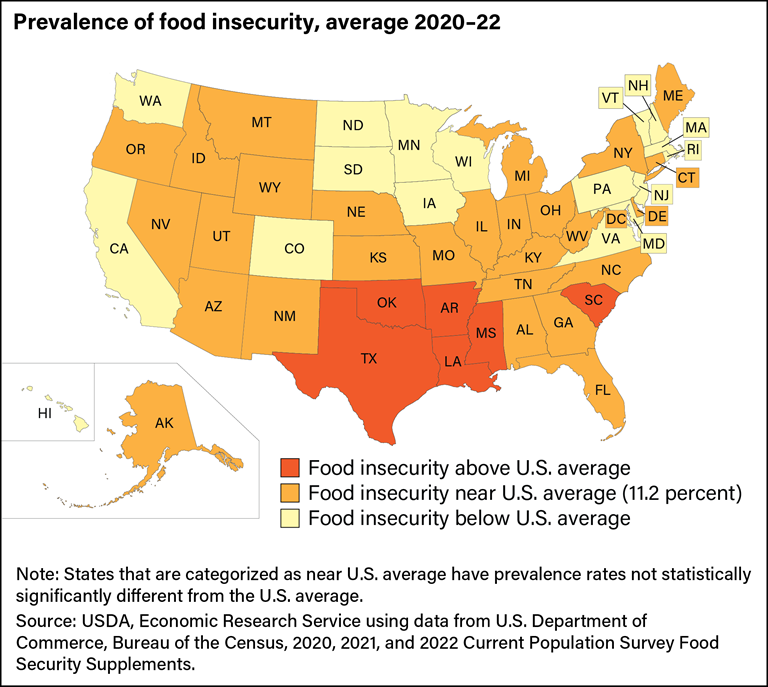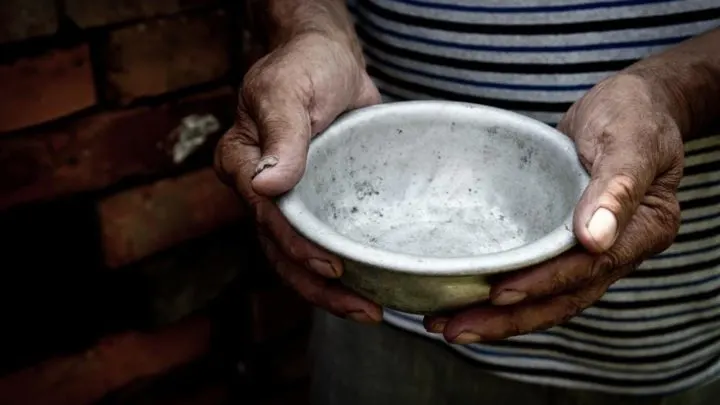As one of the wealthiest countries in the world, many people do not realize that there is shocking food insecurity across the country. In this article, we’ll review the 10 Hungriest States in America as well as the most food insecure cities in the United States.
Over 20 million American households, or about 38.3 million Americans, are food insecure. You may be wondering, what does being food insecure even mean? And why is this happening in our country?
Keep reading to find out why many Americans face food insecurity, how this started, and what the hungriest states in America are.
What does food insecurity in the United States look like?
Food insecurity looks different in every country and state. While it may be hard for many Americans to conceptualize hunger in the United States, when seeing high levels of famine and malnutrition elsewhere in the world on the news, food insecurity is still prevalent within our own country.
The USDA has categorized four levels of food security, to make the topic more understandable for the average American.
The USDA defines four levels of food security:
- Very low food security: This type of food security will lead to decreased and disrupted diets, as well as a lowered food intake. This will result in overall reduced food intake and hunger.
- Low food security: This type of food security may result in little or no change in a person’s diet or amount of food intake. Instead, there will typically be a reduced quality of food, lowered diversity or variety of food, or decreased desirability of diet. Ultimately, this is food insecurity without hunger.
- Marginal food security: This type of food security will also have little to no indication of changes in food intake or diet. However, there will be one or two indicators that there is food shortage or insufficient food supply.
- High food security: This means that there is no food insecurity, and that a household is not experiencing any food-access issues or limitations. There is also a diverse, desirable diet available.
Why is America food insecure?
The Current Population Survey Food Security Supplement from 2020 revealed that the overall number of food insecure households in the United States only slightly increased from 2019 to 2020. In both 2019 and 2020, about 10.5% of households reported some level of food insecurity. Despite this lack of change, the number of households with children facing insecurity did increase from 2019 to 2020, from 13.6% to 14.8%.
This means that in 2020, there were 5.6 million households with children facing food insecurity, representing the first upward trend in child hunger in the United States since 2011. Many children faced increased food insecurity due to a decrease in household income, as well as the lack of access to school meals during the country-wide lockdown.
Now, it’s important to understand why food insecurity existed in the United States prior to the pandemic. According to Feeding America, there are several causes which may contribute to food insecurity, each of which are complex:
- Poverty, low income, unemployment, and under-employment, all can which result in not having enough money to spend on nutritious food. As unemployment has increased during the COVID-19 Pandemic, so has the challenges to afford substantial food.
- The lack of affordable housing, or expensive housing that prevents families from having substantial money to spend on high-quantity and quality food.
- The lack of access to healthcare or chronic health conditions, which may prevent Americans from working and being able to afford food, or being able to afford food that is necessary to treat their chronic health condition.
- Racial discrimination or systemic racism, which may result in food deserts or other barriers that can disproportionately impact a household’s access to food.
What percent of the US is food insecure?
According to the USDA, 10.5% of all American households faced food insecurity at some point in 2019 and 2020.
While more updated data is not yet available, Feeding America estimates that 42 million people, or 1 in 8 Americans, faced food insecurity in 2021.
When did food insecurity start in America?
Food insecurity in the United States is not new. For generations, many Americans have lived in food deserts. Currently, nearly 19 million Americans, or 6% of the overall population, live in a food desert.
A food desert occurs when a low-income community, often a community of color, has limited access to affordable, healthy food. This can occur because there are no nearby grocery stores or there are no public transportation options to get to these stores.
However, these food deserts do not grow naturally. In fact, most food deserts exist due to systemic racism, or generational oppression that has led minority groups to live together in urban areas. Over time, discriminatory housing policies, such as zoning codes, have forced black, Hispanic, and other minority groups into low-income housing areas, where healthy and affordable food is less available.
Where are the hungriest states in America?
Food insecurity in the United States differs by both geographic location and demographics.
For instance, single mother households, and households below the income poverty line, currently face the highest levels of food insecurity. These rates are even higher for black and Hispanic households, as well as households in cities or rural areas, rather than in suburban areas.
As stated, food insecurity differs across the country. As shown on the graph below, food insecurity is significantly above average in the South, especially towards the Midwest, in states such as Texas, New Mexico, and Oklahoma. On the reverse, food insecurity is below the US average in more affluent states on both the East and West coasts, including California, Oregon, Washington, New Jersey, and Maine.
The top 10 hungriest states in the United States, as of 2020, are as follows:
- West Virginia (15.1% of residents are food insecure)
- Mississippi (15% of residents are food insecure)
- Louisiana (14.8% of residents are food insecure)
- Oklahoma (14.6% of residents are food insecure)
- Alabama (14% of residents are food insecure)
- Kentucky (13.8% of residents are food insecure)
- New Mexico (13.4% of residents are food insecure)
- Texas (13.3% of of residents are food insecure)
- Arkansas (12.6% of residents are food insecure)
- Tennessee (12.5% of of residents are food insecure)
Did your state unfortunately make this list? If you are currently experiencing food insecurity, there are many public resources available to help.

What is the most food insecure city in the US?
According to Save the Children, East Carroll Parish in Louisiana has the highest food insecurity rate in the country, where over 40% of children face hunger. These rates are not only staggering within the United States, but are comparable to food insecurity rates for children in developing countries such as Bangladesh, Peru, and Mali.
How does the United States government battle food insecurity?
During the recent global pandemic, the US government’s spending on food and nutritious programs has reached an all time high, especially through the USDA. In fiscal year 2020, the USDA’s programs totaled $122.1 billion in food assistance, which is 32% more than spent in fiscal year 2019.
The United States government has multiple programs to help feed Americans, including SNAP’s Electronic Benefits Transfers (EBTs), the Emergency Food Assistance Program (TEFAP), the expanded child tax credit (CTC), and the more recent direct stimulus checks, to help struggling families during the recent pandemic. Many communities, religious centers such as churches, and schools also run food banks or pantries, where struggling Americans can pick up free, non-perishable food.

